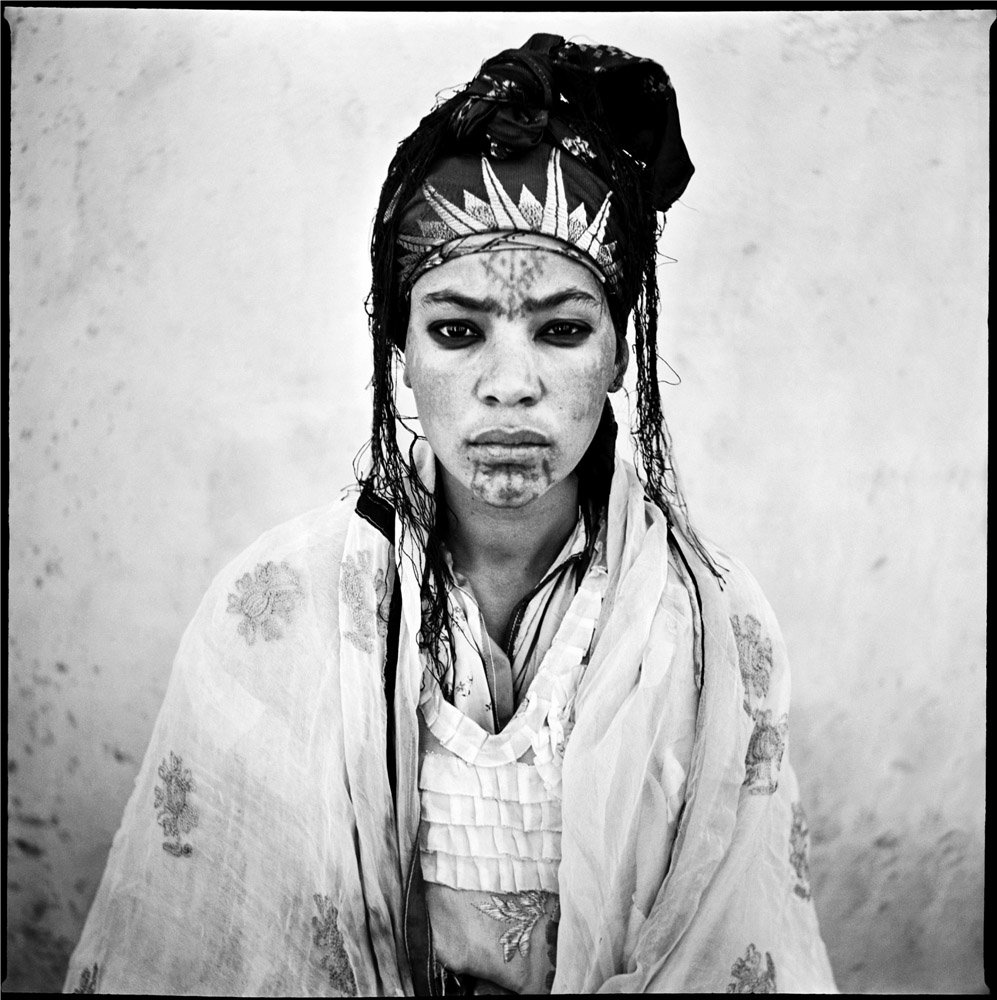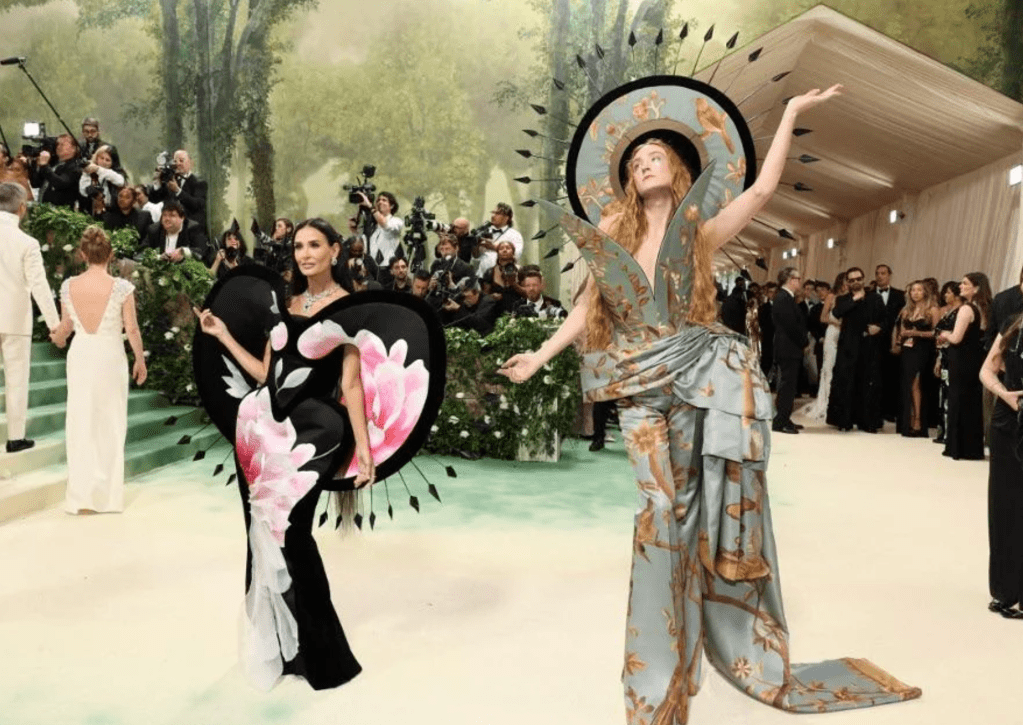
In Franz Fanon’s Algeria Unveiled, the veil is a symbol of taboo for the coloniser who fetishizes it along with his sexualisation of the female Algerian body. It does not mean one, concrete thing because, experientially, it occupies multiple meanings within the woman’s identification. While it can be seen as a form of oppression, it simultaneously puts the Algerian woman in a position of power as she wields the veil as an object of identification with her culture and reverts the meaning placed on it by both Muslim practices, where it is an expression of religious modesty, and the French coloniser, who exoticizes it into a symbol of the Algerian patriarchy.
A space for sexual fantasy is created when the Algerian hides her body from the European. However, the veil and its religious connotations de-centralise the Algerian’s male gaze in public spaces such as the “street”; his attitude lacks the sexual objectification prevalent in Westernised culture where women are completely ‘seen’, because he posits a “permanent intention not to perceive the feminine profile” (Fanon 1989 44). This is not merely because her body is hidden but is also due to his deliberate denial of the behaviour which characterises sexual encounters. Muslim traditions in the Arab world are, according to Fanon, intended to diminish the phenomenology of sexual encounters common in Western cities, which include the glance and the physical effects of arousal felt by the viewer; the veil enables the woman to become practically invisible to this invading gaze.
Fanon prescribes a binary opposition between the meaning of the veil in the Algerian woman’s personal cultural space and the meaning it takes on for the European man. Whereas the Algerian “does not see her”, this “invisibility” of her body draws attention to itself because “this woman who sees without being seen frustrates the coloniser” (Fanon 1989 44). He experiences his relationship with her on a complex level because his lack of access to her body formulates a strange sense of privilege for her identity in this colonial setting. Although she is in the inferior position, she dismantles his power of the gaze, producing within him the desire to see her unveil herself: “he reacts in an aggressive way before this limitation of his perception” (Fanon 1989 44) and, when she is actually unveiled, he often delights in deriding her physical appearance in order to exert dominion over both the woman and the fantasies her veiled existence provokes in him.
Fanon is a psychoanalyst in the sense of his focus on the interpretation of dreams. Although dream-thoughts have meaning, connection and order, in the manifest content of the dream we forget the meaning of the latent content and, through a secondary revision, we create new meanings. However, dream-thoughts can still provide insight into our repressions and unconscious wishes. Fanon’s analysis of the European man’s dreams is an extension of Freudian theory as it allows him to dig beyond the surface of the dreamer’s manifest content. “Aggressiveness comes to light… in the dream material revealed in the European” (1989 44) and the manifest content of the European’s dreams produces a “dynamic image” of rape, eroticism and sadism that creates faults through which the dreamlike forms of behaviour can lead to real instances of rape. Every dream-rape he analyses includes “a double deflowering” where the sexual act is “preceded by a rendering of the veil” and she never consents to the intercourse- her attitude is rather one of “abject humility” (Fanon 1989 49). The coloniser’s fantasy to possess, unveil and humiliate the Algerian woman aligns with his aggressive ideological motives of possessing and dominating Algeria.

However, the European fetishizes the veiled woman in the broad, rather than Freudian, sense of the term. Freudian psychoanalysis suggests a fetish is a replacement for something that cannot exist, a denial of reality where the knowledge that something is not true does not affect one’s relationship to it. A Freudian reading of the veil suggests that the European gives it an overvalued importance. In terms of religion, individuals worshipped an object as a God and their ‘fetish’ was not merely this objectified and representation of a deity, but rather the object itself became the God in his mind. According to Freud, this kind of idolatry was the origin of religion.
The cognitive processing which allows the primal man to place value onto animals and inanimate objects, representatives of man’s spiritual expression, is very different to the fetishist, whose trauma stems from the realisation that his mother lacks a penis (Freud and Strachey 1927 152) and who places sexual value onto objects to replace something that does not exist- the mother’s phallus. However, both retain the same fundamental concept of placing a symbolic meaning onto a representative object. Freud’s ‘fetishism’, as a technical term, refers to the trauma that there is no maternal phallus, leading to the fantasy reconstruction of the phallic mother (1927 151). The fetish becomes a substitute for the woman’s literal penis, as the meaning and purpose of it is to preserve this phallic idea that the child does not want to give up. It does not change its relationship to the object, refusing to take cognizance of his perception that women have been ‘castrated’, because this endangers his own possession of a penis. Narcissism is attached to this castration complex and, therefore, a similar panic is experienced later. He ‘scotomises’ his perception of the woman’s lack of penis as he attempts to ‘wipe’ this perception away from his consciousness (Freud 1927 152).
Fanon’s idea of the European’s fetishization refers to his excess sexualisation of the Algerian woman in the colonial context because his irrational need to unveil her is the desire to assert dominance. In a Lacanian reading, alternatively, the veiled woman as a signifier could even take on the symbolic role of the phallus itself. In contrast, Freud, who generalises from specific case studies, could read this fetishism in a decontextualized setting, potentially reducing it to a fetishist’s symbolic representation of the mother’s phallus, which doesn’t necessarily have to resemble the penis literally (Freud 1927 154). This psychological process would involve a trauma absent from idolatry or totemism as it involves ‘traumatic amnesia’ where the last ‘memory’ of the woman’s ‘penis’ is retained as a fetish. For example, undergarments perhaps symbolise the moment of undressing when the mother could still be regarded as phallic. Therefore, a Freudian reading could examine the hostility in the treatment of the veil, which aligns with a lesser proportion of affection, as it runs parallel with the disavowal and acknowledgement of castration on the part of the European’s need to uncover her (Freud 1927 156). The European man could be frustrated, sexually and otherwise, by the lack of undress symbolised through the veil’s hiding of the female organs, inducing the traumatic memories associated with his discovery of the woman’s ‘castration’.
The notion of fetishism in relation to God stemmed from ethnography, entering the European discourse with a sense that something overvalued possessed a power it shouldn’t have. The Marxian idea of a ‘commodity fetish’ is useful in 19th century intellectual dialogues where the fetish was a symbolic object, historically worshipped as supernatural by the primal man in indigenous cultures, as depicted in Totem and Taboo. In this sense, Fanon’s reading of the veil as a symbol of the Algerian woman’s power in the face of the European could align with the Freudian idea of the fetish, because a piece of clothing transforms into something which must be dominated, overturned and unveiled because it takes on an alluring value for the coloniser who is intrigued by her hidden physical and mental state. Freud’s method of examining particular cases where man attributes value to inanimate objects as symbols capable of rendering power could be read as similar to the way Fanon illustrates the European’s relation to the veil as an object which gives the woman a power she ‘shouldn’t have’ (in the context of his colonisation of both her body and land). Fanon’s Marxist influence suggests that man seems to fetishize certain objects because they take on symbols of power which they desire, which he seeks to both discover and usurp. In contrast to Freud, it is clear that the politicisation of Fanon’s psychoanalysis also sociologically looks into the veil as something which genuinely began to possess power for the colonised woman. Therefore, Fanon’s notion of fetishization is not used in this psychoanalytic sense of fetishism.

Although, through this policing of clothing, the Algerian woman is othered by the Muslim patriarchy in terms of sexual autonomy, the coloniser others her gendered existence by exoticizing her cultural identity along with her status as a woman. There is a sense that these vestimentary codes of dress in Islam oppress women. However, while there are some uncomplicated ways in which they do from the perspective of feminist emancipatory ideals, there is also a form of power for the veiled Algerian woman who is able to see without being seen. One operates in the world by reading the Other’s facial expressions and body language, which is important in creating a dominating power relation for the coloniser. However, when he is unable to gauge the woman’s mental sphere, he is denied knowledge of how to pursue his domination because he cannot utilise visible cues to assess whether she asserts a challenging, fearful, or already dominated demeanour.
Vision itself is the sense utilised best in dehumanising individuals; it has been linked to expressions of objectification and dehumanisation because it does not require reciprocity, allows the process of categorised information, and enables the perceiver to pin down the object of their gaze. Even from a distance, one’s gaze can mentally affect a person by making them aware of their status as a visual object (Scheman 159). The veil denies the coloniser a visionary effect on the female consciousness which he would be able to assert if given full visual access to her body; the politicised gaze cannot be yielded to make her aware of her objectification. The European is therefore not able to fulfil his fantasy by “revealing her beauty” and “making her available for adventure” in order to render her a possible object of possession. This denial of his vision produces his fantasy that the Algerian woman is “queen of all women” (Fanon 1989 43) and he seeks to uncover her hidden world of mystery in a way where the colonisation of her body almost metaphorically represents his possession of Algeria.
In response, even Algerian women unconcerned with wearing the veil initially wore it as an anti-colonial signifier of resistance against an attack on their culture in order to “deny the rape of the coloniser” (Fanon 1989 42), which succeeded with every unveiled face and body. As women were slowly permitted to actively enter the revolutionary struggle, they then discarded the veil in order to deceive the coloniser, disguising themselves as Europeans to transport resources through the European city and help the guerrilla revolutionary efforts (Fanon 1989 50). Fanon highlights a sense of agency which is not as present in the English translation. The French title, L’Algérie se dévoile, is translated as a reflexive, rather than passive, construction: ‘Algeria unveils itself’, as opposed to Algeria Unveiled. Therefore, Fanon seeks to emphasise the complex power dynamics attached to the veil as a political symbol which moves between many meanings and attaches itself as a weapon of autonomy for the woman, despite being viewed as a solely patriarchal device by the Europeans.

Wearing the veil is initially a sign of resistance to the Western pressures destroying the Algerian culture, as even non-religious women wanted to keep their organic culture intact. Later, women began to remove the veil in order to sneak into Western towns and those not involved in the revolutionary tactics also modified their appearance, Westernising themselves as a symbol of willingness to confront the oppressor on their own territory. Finally, the veil was reassumed again as a form of disguise: “Removed and reassumed again and again, the veil has been manipulated, transformed into a technique of camouflage, into a means of struggle” (Fanon 1989 61). Even without the veil, she operates on “camouflage” through a manipulation of her body and “moves like a fish in the Western waters”, carrying “revolvers, grenades, hundreds of false identity cards or bombs” (Fanon 1989 58). This analogy and animalistic metaphor is used to distinguish the encounter between the unveiled Algerian woman and the European man, which doesn’t occur amongst the Algerian natives. Fanon implies that, if the completely covered Algerian is invisible and underestimated in the social space, then the unveiled European woman is also invisible to the soldiers who see her as a young, harmless woman they can flirt with, rather than an autonomous person capable of participating in the revolution.
Although Fanon is more empirical than Freud and does not look at deep childhood structures, he also psychoanalytically explores trauma. As unveiling had been taboo for many Algerians, certain women who had to westernise themselves saw it as a violation. They didn’t merely feel “naked” or exposed, but also had to relearn their own spatial relationship in the public sphere. The Algerian woman had to be public in a different way because “the veil protects, reassures, isolates…without the veil she has the impression of her body being cut up into bits, put adrift; the limbs seem to lengthen indefinitely… the body seems to escape, to dissolve” (Fanon 1989 59). This sense of loss in her identification makes her anxious and unaware of herself even though she must overcome this awkwardness in order to pass as a European, while simultaneously maintain a carefulness not to attract too much attention to herself. She relearns and re-establishes this new dialectic of her body “in a totally revolutionary fashion” (Fanon 1989 59) and therefore the colonial structure is dominated by women who possess a space that resists control. Although her experience was difficult, the Algerian was able to gain power because, despite being made invisible by the Algerian patriarchy, in some ways this gave her leverage over the coloniser. Foucault’s ‘panopticon’ tower example can draw an analogy between prison constructions in the 18th century and the veiled woman’s power to see other people without allowing herself to be seen. The person at the top of the power cannot be seen yet is always able to see inside every single cell, creating a form of psychological torture: wherever the prisoner hides, a guard could be viewing them at all times (Schrift 146). Even if the prisoner does not know he is watched, his assumption is enough to control his behaviour because, once given this structure, he will act is if he is being watched. Therefore, the veiled woman can subvert the identification by transforming the meanings of her veil.

However, despite these revolutionary strategies, the sexual violence against these women and the colonial violence in Algeria is structurally paralleled by Fanon because the privacy she possesses is also symbolic of the spaces she occupies. As Fanon describes in Colonial War and Mental Disorders, the Algerian woman is often raped in order to affect the Algerian man; it is an action of domination over the objectified, colonialised subject. “That wasn’t a simple rape, for want of something better to do, or for sadistic reasons …; it was the rape of an obstinate woman, who was ready to put up with everything rather than sell her husband…to punish her for keeping silence that she was violated” (Fanon 2001 9). Fanon’s psychiatric work with mental patients, including men, supports the narrative that the European, by dominating the woman, sought to dominate the man in ways emblematic of colonial power. Colonialism involves a psychological bullying which breaks down Algerian society so that they have nothing to resist. By threatening symbols of Algerian ideology, such as traditions like the veil, Algerians can more easily be indoctrinated into Western culture where subservience is ensured. Colonialist situations of warfare pivot on the consistently sexist idea that women are the weak link that can be seduced and won over because, by promoting “solidarity with Algerian women” against “a centuries old subjugation”, they sought to break the patriarchal structure of Algeria in order to break the whole country. By removing these restrictions on women, it gives them more power and thus retrieves power away from the men, penetrating the surface of the deep Algerian patriarchy’s social order. The goal of undermining society through the Westernisation of women, via the assumption that they will see this as a liberation, is intended to also undermine the Algerian men. Therefore, Algeria Unveiled creates a message heavy with irony which suggests that European patriarchy and traditional Islamic patriarchy are not opposed because they create certain kinds of invisibility for women. However, while the revolution provided opportunity for acts of independence, no Algerian woman could be truly liberated until Algeria liberated itself from France, irrespective of any emancipatory behaviours (Reid 461). Nevertheless, the coloniser’s dismissal of women in warfare also renders the European women as invisible in ways which the Algerian woman is not because she knows how to utilise all her forms of invisibility.
The focus on the experience of the young Muslim woman can be seen as surpassing Fanon’s psychoanalytic basis because his phenomenological roots are emblematic in the perceptions of the Algerian woman’s body as it moves through space. Macey argues that Fanon was not a psychoanalyst but rather spoke to the phenomenological writings of Sartre and Merleau-Ponty, as in previous texts such as Black Skin, White Masks (97). Direct allusions to Freud are surprisingly rare, with the exception of his dissertation. Even in Colonial War and Mental Disorders, he derives no categories of war neurosis and torture from the wide literature of psychoanalysis available on the topic. He focused on psychiatry as a doctor of medicine whose psychoanalysis was primarily theoretical at the beginning of his work (Macey 100) and his examination of the veil’s transformative meaning follows his tradition of incorporating Sartrean existentialism to theorise the process of re-learning one’s body and self-constructing the people we are (Nicholls).On the level of the individual, the European’s fantasies of sexual violence, an integral part of colonial situations (Fanon 1989 45), also differs from Freud’s use of fantasies in relation to the fetishization of the ‘maternal phallus’. Furthermore, Fanon departs from a rigid psychoanalytic view that the veil would always have one meaning, while simultaneously describing the unveiled Algerian woman’s psychological relearning.

Ultimately, Fanon’s psychoanalytic method is heavily empirical, and his examination of the body as a physical space is clearly influenced by phenomenological and existentialist discourses by philosophers such as Sartre, in ways which allow him to innovatively examine the colonised psyche. Therefore, his reading of cultural practices allows readers an insight into the importance of cultural, political and historical contextualisation, which is contrastingly limited in Freud’s broader cultural readings. However, Fanon’s post-colonial psychoanalysis allows us to see an extension of Freud’s original ideas and their application to real political situations, accounting for trauma that effects the individual and collective spaces. Freud and Fanon’s uses of technical terms, such as fetishization, would provide different readings of symbols like the veil and Fanon departs from meanings centring around the phallus and the Father, whereas Freud’s symbolism is generally fixed. Nevertheless, Fanon and Freud both provide accounts for the signification of meaning and symbols in different contexts, creating a similar structural, psychoanalytic generalisation of the many to the individual.
Works Cited
Calvo, Luz. “Racial Fantasies and the Primal Scene of Miscegenation.” International Journal of Psychoanalysis, vol. 89, no. 1, 2008, p. 55.
Fanon, Frantz. “Algeria Unveiled.” Studies in a Dying Colonialism. Earthscan Publications, 1989, pp. 35-67.
Fanon, Frantz. “Colonial War and Mental Disorders.” The Wretched of the Earth. Penguin, 2001, p. 9.
Simek, Nicole. “Postcolonial Freud: Psychoanalysis in the French Antilles.” Edinburgh University Press Journals, vol. 13, no. 2, 2011, pp. 230-231.
Freud, Sigmund. “Fetishism.” The Standard Edition of the Complete Psychological Works of Sigmund Freud, Vol. XXI (1927-1931): The Future of an Illusion, Civilisation and its Discontents, and Other Works, The Hogarth Press and the Institute of Psychoanalysis. Trans. James Strachey. 1927, pp. 147-158. Available at: http://0-www.pep-web.org.pugwash.lib.warwick.ac.uk/document.php?id=se.021.0147a#p0149.
Freud, Sigmund. “The Taboo of Virginity (Contributions to the Psychology of Love III)”. The Standard Edition of the Complete Psychological Works of Sigmund Freud, Volume XI (1910): Five Lectures on Psycho-Analysis, Leonardo da Vinci and Other Works. Trans. James Strachey. 1961, pp. 191-208.
Freud, Sigmund. Totem and Taboo. Trans. James Strachey. Routledge, 2001.
Georgis, Dina. “Freud, Fanon and the Difference Desire makes.” Emotion, Space, Society, vol. 30, no. 40, 2019, p. 3.
Lacan, Jacques. “The Signification of the Phallus.” Ecrits: The First Complete Edition. Trans. Bruce Fink. W.W. Nortan & Company, 2007, p. 579.
Lévi-Strauss, Claude. “A Jivaro Version of Totem and Taboo.” The Jealous Potter. Trans. Benedicte Chorier. The University of Chicago Press, 1988, p. 185.
Macey, David. “The Recall of the Real: Frantz Fanon and Psychoanalysis.” Constellations: An International Journal of Critical Democratic Theory, vol. 6, no. 1, 1999, p. 100.
Nicholls, Tracey. “Frantz Fanon (1925—1961)” IEP, N.D., https://www.iep.utm.edu/fanon/#H4, Accessed 6th May 2019.
Reid, Donald. “The World of Frantz Fanon’s ‘L’Algérie se dévoile’”. French Studies, vol. 61, no. 4, 2007, pp. 461-464.
Scheman, Naomi. “Thinking about Quality in Women’s Visual Art.” Engenderings: Constructions of Knowledge, Authority, and Privilege. Routledge, 1993, p. 159.
Schrift, Alan. “Discipline and Punish”. A Companion to Foucault. (eds) Falzon, Christopher, O’Leary, Timothy, Sawicki, Jana. Blackwell Publishing, 2013, p. 146.
Ziarek, Eva Plonowska. “The Future of the Revolt or the Future of an Illusion?” Southern Journal of Philosophy, vol. 42, no. 1, 2004, pp. 32-33.
I do not own any images.















Leave a comment